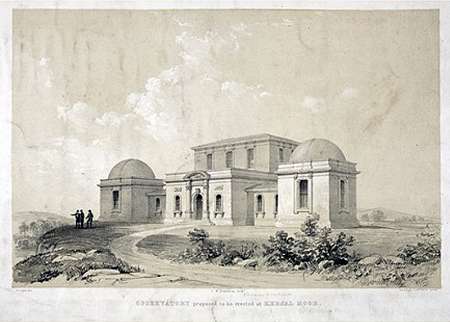Proposed Observatory Kersal Moor
PROPOSED ASTRONOMICAL OBSERVATORY NEAR MANCHESTER - On Monday last a meeting of gentlemen was held at the York Hotel, King Street, to consider the propriety of establishing in Broughton or its vicinity, an astronomical observatory, having for its objects, the illustration both of the theory and practice of the science. Mr John Davies was called to the chair, and addressed the meeting at some length. ...... A provisional committee was appointed to proceed with the undertaking, and to make the required preparations for a general meeting of the subscribers. [Manchester Guardian 29 December 1838 page 2]
OBSERVATORY AT BROUGHTON - On a former occasion we noticed the proposals for establishing an observatory in the township of Broughton for the advancement of popular instruction in the science of astronomy, meteorology etc. with the observation and registry of magnetic phenomena. By the prospectus, we learn that "an effort will shortly be made by the highest scientific authorities in the kingdom, to obtain a grant from the national resources for the promotion, in remote regions, of investigations which are already instituted; and it may not unreasonably be hoped that an observatory, situated in the vicinity in which Dr Dalton made his great discoveries, may contribute something to the general stock of information on the subject. With a view to the furtherance of these objects (continues the prospectus), it is intended to erect a suitable building on a very favourable site, lying on that side of Kersal Moor nearest to Manchester, the estimated cost of which is £3,000; to procure instruments of the finest quality, a list of which is subjoined, and which it is expected, will require an additional outlay of nearly £2,000; to form an extensive collection of the best works on astronomy, optic, and meteorology; and to engage the services of a competent astronomer, who, together with an assistant, will have to observe and record the various phenomena of the heavens and atmosphere, - to furnish for the inspection of the members, a daily register of the most important of them; to prepare for publication, and carry through the press, such observations as it may be thought desirable to lay before the world; to keep up a correspondence and an interchange of information with similar institutions; to explain the several processes and instruments employed in the observatory; to expound the great truths of astronomical and meteorological science; and to deliver lectures, especially when astronomical phenomena of particular interest occur.
PROPOSED INSTRUMENTS: ASTRONOMY - A transit circle, 3 feet 6 inches diameter with an achromatic telescope 8 feet 6 inches focal length and 6 inches aperture; an equatorial telescope, 8 feet 6 inches focal length; object glass 6.5 inches diameter, with polar axis, clock, etc. An achromatic telescope 6 feet focal length, 3.75 inches diameter; Camera obscura, 10 feet focus. an astronomical clock; an astronomical beater; achromatic solar microscope; doublet and compound microscopes, and an extensive collection of minor astronomical instruments, and philosophical instruments, together with orreries, globes, maps, charts, rotulas, sections, calculations etc.
METEROROLOGY - Barometer, thermometer, hygrometer atmometer, self-registering rain gauge, anemometer
MAGNETISM - A complete set of magnetical instruments, as made by Professors Gauss and Weber, of Gottingen, and now used in the best scientific institutions.
The provisional committee state that the object at which they aim, as well as their plans for its execution, have received the approbation of Sir John F W Hershel FRS MRIA FRAS FGS MCUPS etc.; of James Challis MA Plumian Astronomer, Cambridge, and W H Miller MA, Professor of Minerology, Cambridge.
We have received a lithographed print of the elevation in perspective of the proposed observatory, from a plan by Mr T W Atkinson, architect, of this town. It is intended to crown the eminence, immediately above the projected Marlborough Crescent on Kersal Moor, its principal front being to the south, and commanding a view, a little to the west of Hulme church, by Old Trafford, with the Cheshire hills in the distance. From the circumstances of south-westerly winds prevailing here during about nine months of the twelve, it is anticipated that the view in this direction will be generally clear and free from smoke, while the horizon will be one of the best that can be had in the immediate neighbourhood. The proposed edifice, as represented in the plate, is a handsome Ionic structure, consisting of a vestibule and square centre, with two square wings, surmounted by unlighted domes, and united to the centre by corridors. The entrance hall, or vestibule is but one floor; and its roof, being covered in lead, forms a plane terrace for out-of-door observations, the windows of the principal telescope room opening upon it. The right or west wing of the building is to be devoted to the transit circle, with achromatic telescope, etc; the left or east wing to the equatorial telescope, with polar axis, etc. The centre room on the second floor, containing three windows on each of its four sides, is intended to contain the instruments and apparatus for popular instruction and gratification - telescopes, microscopes, camera obscura etc. We understand that it is intended to afford occasional admission to members of the popular institutions in Manchester and Salford, as well as the labouring classes, under certain regulations. [Manchester Guardian 24 August 1839 page 2]
At the time Kersal Moor extended down to the River Irwell. The proposed site would appear to be close to the present-day Blackfield Lane and a short distance from the new turnpike, otherwise Bury New Road.
